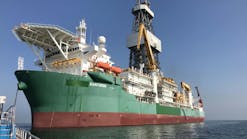Judy Maksoud
International Editor
The North Sea is still an active exploration area, and new licensing structure offshore Great Britain could increase drilling activity. Norway is ramping up to develop Ormen Lange and is looking to the Barents Sea for additional development opportunities.
In Europe, the offshore areas that will see the highest growth rates in the next few years are the Mediterranean and Black seas.
UK and Western Europe
Late last year, Aberdeen's Ramco Energy plc and the Seven Heads partners brought the Seven Heads gas field into production.
Seven Heads is adjacent to Ireland's largest producing gas field, Kinsale field, which is operated by Marathon. Proximity to existing infrastructure enabled Ramco to fast track Seven Heads development via a subsea pipeline tied back to the Kinsale facilities.
Production from the Seven Heads field is expected to contribute 10-15% of Ireland's gas demand in 2004, displacing imports from the UK.
Ramco has acquired interests in several other blocks in the Celtic Sea and is planning a seismic work program for 2004 to assess the potential for future development of satellite structures that could be tied back to existing infrastructure.
In March 2004, the UK saw the announcement of the biggest oil and gas licensing round in nearly 40 years. The 22nd Offshore and 12th Onshore licensing rounds included an innovative license meant to increase oil and gas activity on the UKCS.
The new "frontier" license targets activity in the West of Shetland region, much of which has not been offered for licensing in many years. The licensing round opened 1,039 offshore blocks and partial blocks.
Last September, Great Britain and Norway agreed on treaty principles that will enable gas to be transported from the Ormen Lange field offshore Norway to the British market. The agreement is based on delivery of third-party gas through the southern leg from the Sleipner riser platform to Easington in the UK by October 2006.
Deliveries of gas from Ormen Lange will start through the northern leg from Nyhamna to the Sleipner riser platform in October 2007.
The Ormen Lange field is the largest gas field under development on the Norwegian continental shelf. The planned volumes to be exported to the UK amount to nearly 20 bcm/yr over a 20-year period.
Offshore Denmark, Dansk Olie og Naturgas made history in September 2003 when the Siri platform began producing oil from the Nini and Cecilie fields in the North Sea. This project is the first for which DONG acted as operator from exploration to operation.
Together, the fields are expected to produce 25,000 b/d of oil in 2003, increasing to 30,000 b/d in 2004. The fields will continue to be developed with more production wells.
Black and Mediterranean seas
In October, Total and Rosneft signed an agreement to explore and develop the Tuapse Depression in the Black Sea. Rosneft was awarded the exploration license for the 12,000-sq-km area in August 2003. The license is to be transferred to a joint venture equally owned by the two companies.
Last November, Melrose Resources floated the Galata platform out of the shipyard in Varna, Bulgaria, and began installing it on the Galata gas field 19 km from shore. The 80-bcf field is expected to produce for seven years. First production was scheduled for January 2004.
Most of the offshore activity in the Mediterranean has been offshore Egypt. BG began the second phase of development for the Rosetta field at the end of January. An unmanned minimum facilities platform will be tied back to the existing platform to bring new gas fields onstream. First gas is scheduled for July 2005.
Shell Egypt made two ultra-deepwater hydrocarbon discoveries in a three-well campaign in the North East Mediterranean Deepwater Concession in the Nile Delta. The wells, drilled in over 2,400 m of water, set new water depth records for Egypt. Shell announced last year it would invest $1 billion in exploration over the next several years on its North East Mediterranean field.
Apache Corp. will begin appraisal drilling on the West Mediterr- anean concession and start infrastructure construction soon.
A seismic agreement signed in January 2004 points to possible development in the eastern Mediterranean. Syrian Oil Co. reportedly signed a contract with Veritas DGC to gather seismic, geological, and geophysical data. And Libya is planning a licensing round for early 2004. With the United Nations lifting sanctions in September 2003, the way is open for increased foreign investment. The country is actively encouraging US companies to return.
Shell signed a Heads of Agreement with.Libya in late March 2004 and will continue negotiations on specific projects in Libya this year.
In October, Intec Engineering was awarded the front-end engineering and design (FEED) contract for the Medgaz offshore pipeline project in the Mediterranean Sea.
EPIC contract activities are to begin during 3Q 2004, following project approval by appropriate authorities in Spain and Algeria.






